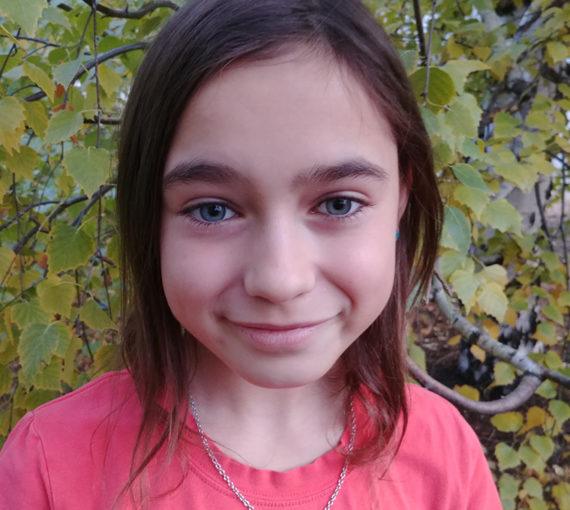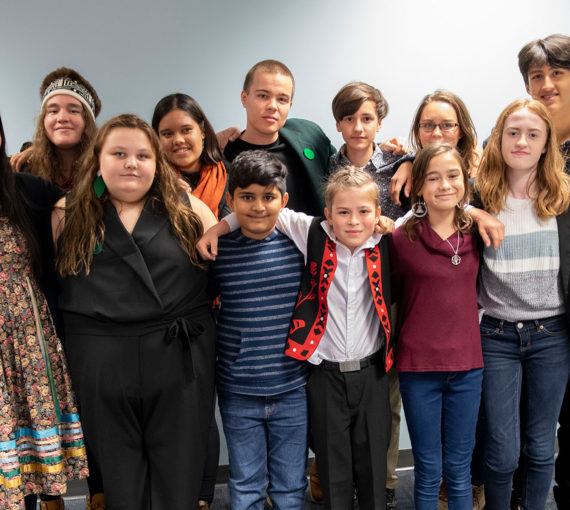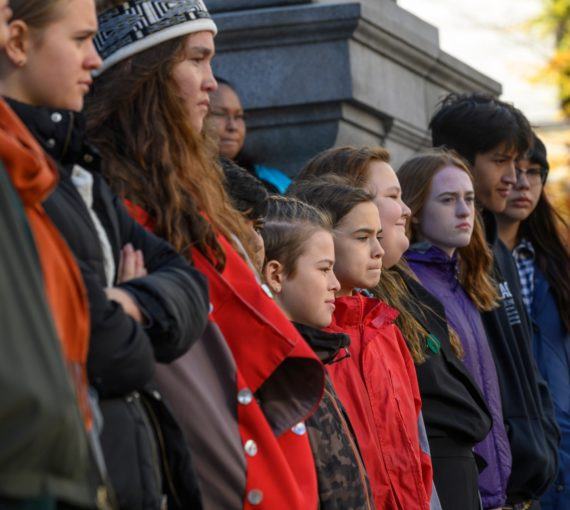
Canada’s leading young climate activists announce the launch of their lawsuit against the federal government for contributing to dangerous climate change. (Photo: Robin Loznak via Our Children’s Trust)
On October 25, 2019, 15 Canadian youth, representing seven provinces and one territory, filed a lawsuit in the Federal Court of Canada.
They’re alleging that the federal government causes, contributes to and allows dangerous levels of greenhouse gas emissions and is responsible for the specific, individualized climate change impacts they are experiencing.
This case moves the Canadian youth climate movement from the streets to the courts. It aims to change how we govern, run our economies, and protect and preserve a safe, livable climate for future generations.
The youth are supported by the David Suzuki Foundation, Pacific Centre for Environmental Law and Litigation and Our Children’s Trust and represented by law firms Arvay Finlay LLP and Tollefson Law Corporation.
We’re inspired by these brave, bold young climate leaders. This is the first of three posts introducing the plaintiffs. Stay tuned for more of their stories.
For more information, read our October 25 news release.
Meet Canada’s young climate activists

Albert (Montreal, Quebec)
”The environment must be our absolute priority because otherwise, nothing makes sense. Government’s refusal to act on climate change according to what science states is needed for survival is violating young people’s right to be young.”
Climate activist Albert Lalonde is a spokesperson for Devoir environnemental collectif, an organization representing the pre-university colleges known as les colleges d’enseignement general et professionnel, or Cegeps, and a broader student coalition. Experiencing severe heat waves and flooding in Montreal, Albert turned to organizing and activism as a response to climate anxiety.
Photo: Félix Legault-Dignard

Lauren (Saskatoon, Saskatchewan)
“I am taking action against the climate crisis because I refuse to accept an uninhabitable future for all habitants of our beautiful planet. This is a problem for every single one of us. I ask you to join me in doing what needs to be done for climate action now.”
Lauren loves spending time outdoors on the South Saskatchewan River, canoeing and fishing with her father. In recent years, however, she has found it increasingly difficult to do the activities she loves because water levels have been so low. She has also witnessed the effects of climate change, including drought and extreme temperatures, on the local agricultural industry, which her extended family depends on.
Lauren has channeled her concern into action by planning rallies and organizing marches at her school. She has also pressured the City of Saskatoon to create a youth climate change advisory committee.

Lucas (Ottawa, Ontario)
“As youth, we have dreams for the future. Without a stable climate, our generation will not fulfil these dreams. Climate change affects us all, and I want to do my part so that together we convince the politicians and the adults of today to do what’s right for tomorrow.”
Lucas’s mother is Gwich’in from Fort McPherson and his father is francophone from Quebec. He was born and grew up in Inuvik in the Northwest Territories. Lucas worries that the Gwich’in culture, which is deeply intertwined with the porcupine caribou herd, is threatened by climate change. Over the past two winters, the outdoor rink where Lucas loves to play shinny hockey was often closed in January and February because of warm weather and rain. He worries that other young Canadians may not have the opportunity to play outdoor hockey in the future.
Lucas attends a French school and specializes in cinema and photography.

Sadie (Calgary, Alberta)
“I fight the climate crisis because I want my future to be a good one. I want a home for humanity and for all of the animals that are and will be on the brink of extinction. So help us. Help our future. Just do what you can.”
Outdoor activities like cycling, hiking and downhill and cross-country skiing have been part of Sadie’s life for as long as she can remember. Spending time in the forests, prairies and badlands around Calgary, and in more remote areas of Western Canada, rejuvenates and energizes her. But the effects of climate change, particularly wildfire smoke and declines in snowpack on the mountains, limit her ability to enjoy being active outdoors.
Sadie’s growing concerns about climate change have inspired her to attend school strikes and other protests, speak to Calgary city council about climate change, adopt a vegetarian diet and reduce her carbon footprint as best she can. But she believes she can only really protect herself and her home if government takes decisive action on climate change and reducing greenhouse gas emissions.

Sáj (Melfort, Saskatchewan)
“The planet is dying. The animals are dying. We will all die if we don’t act. As an Indigenous vegan, I fight for Earth and her inhabitants. The youth have to step up because no one else has. We need you to join us to end this climate crisis.”
A member of the Carry the Kettle (Cega’Kin) Nakoda Nation, Sáj lives in a rural farming community surrounded by thousands of lakes and wetlands. She enjoys outdoor activities like camping, hiking, canoeing and rock-climbing.
In recent years, Sáj has witnessed unprecedented flooding in her community, which has devastated homes, farmlands, crops and roads. She has also experienced intense summer heat, extreme cold in winter and wildfire smoke that left her unable to be active outdoors in the places she loves. Deeply concerned about climate change and how it will affect her future, Sáj is an ethical vegan and, as part of the Climate Save Movement, she participates in strikes, protests and rallies throughout Saskatchewan and Canada.


